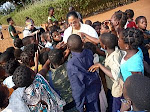Using specific examples from the
readings and the video, critically discuss what stands out as most significant
about African traditional religions in the face of European imperialism. How did African spiritual culture impact
Christianity, Islam and other parts of foreign culture that came to Africa?
What examples dispel the myths and misconceptions of African traditional
religion?
“When the missionaries came to Africa they
had the Bible and we had the land. They said, 'Let us pray.' We closed our
eyes. When we opened them we had the Bible and they had the land.” This quotation by Desmond Tutu is
somewhat puzzling since Tutu is a cleric himself. This is the contradictory nature of African
Spiritual culture and the relationship with the major religions of Christianity
and Islam. As the videos about South
African soccer players and their mix of both traditional and other faiths show,
that European imperialism did influence indigenous Africans toward Christianity
and Islamic religions, but Africans have not forgone the traditional faiths and
practices of their forefathers.
The misconception and myths that surround traditional
religious practices are held by some Africans as well as outsiders. However, as chapter 22 of Africana Studies indicates many of these
missionaries held strong alliances with the colonizers (as with the Portuguese
and the Catholic Church) and held fast to racist ways and beliefs. Although successful in ridiculing or
degrading indigenous beliefs, they were commonly practiced in communities and
homes away from the watchful eyes of those whom deemed them primitive.
As shown on the videos, these beliefs have stood the test of
time. Most of the players in this
updated South African version appear to welcome both beliefs openly. However the misconceptions are depicted by
the South African Sangamo (or Spiritual Adviser) as she states that many look
at these practices in a negative or primitive sense without the appreciation of
the contextual place that this Faith has provided for centuries. As she and the players described in the video,
many looked at traditional faith for protection and consultation from their elders. The Sangamo also described many of the
concoctions were herbal healing remedies that addressed both medical and
non-medical issues.
Without the veil of barbarism, traditional healing,
spiritual advisers and other traditional religions, have found their way into
many different cultures as those African diaspora have interspersed traditional
cultural beliefs with those countries in which they are now living (such as
shown in the African-Brazilian population).
Even as African-Americans practice their faith in many denominations,
the African influence is palpable. The
lively upbeat tempo in the Pentecostal church compared with the solemn rituals
in a white catholic church is reminiscent of the lively African traditional
ceremonies in many countries.
